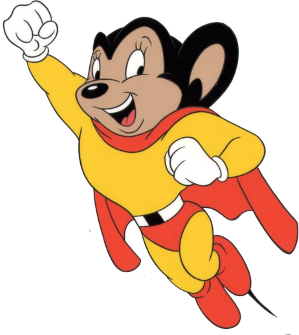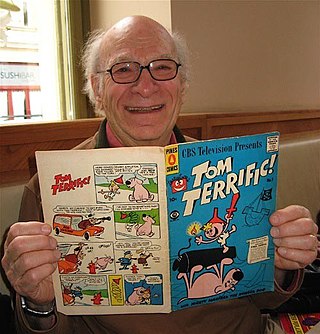
Kiko the Kangaroo is a fictional kangaroo appearing in theatrical cartoons produced by Terrytoons. [1] He is featured in ten cartoons made between 1936 and 1937. [2]

Kiko the Kangaroo is a fictional kangaroo appearing in theatrical cartoons produced by Terrytoons. [1] He is featured in ten cartoons made between 1936 and 1937. [2]
As with various anthropomorphic animals at the time, Kiko wears shorts and shoes. While he does not speak, the marsupial is skilled in hand-to-hand fighting, and would use his prowess to defend his troubled friends or subdue an opponent in a boxing match. He can also use his tail for various purposes.
Kiko was created by Terrytoons in a desperate attempt to rival characters of other studios. [3] He first appeared in Farmer Al Falfa's Prize Package as a pet sent to the farmer by the latter's brother. Since then, the kangaroo would spend the rest of his short theatrical run in a series of his own. After only ten cartoons were released, plans were made to create another cartoon featuring him, only to be not approved by Paul Terry.
Kiko is also among the few characters of the studio to have a theme song. He also has merchandise including plush toys.
Below is a list of films in their original titles. Some of them later came with alternate names when distributed by other companies like Castle Films.
| Film | Release date |
|---|---|
| Farmer Al Falfa's Prize Package | July 31, 1936 |
| Kiko and the Honey Bears | August 21, 1936 |
| Kiko Foils the Fox | October 2, 1936 |
| A Battle Royal | October 30, 1936 |
| Skunked Again | December 25, 1936 |
| Red Hot Music | March 5, 1937 |
| The Hay Ride | April 12, 1937 |
| Ozzie Ostrich Comes to Town | May 28, 1937 |
| Play Ball | June 11, 1937 |
| Kiko's Cleaning Day | September 17, 1937 |

Mighty Mouse is an American animated character created by the Terrytoons studio for 20th Century Fox. He is an anthropomorphic superhero mouse, originally called Super Mouse, and made his debut in the 1942 short The Mouse of Tomorrow. The name was changed to Mighty Mouse in his eighth film, 1944's The Wreck of the Hesperus, and the character went on to star in 80 theatrical shorts, concluding in 1961 with Cat Alarm.

Terrytoons was an American animation studio headquartered in New Rochelle, New York that produced animated cartoons for theatrical release from 1929 to 1973. It was founded by Paul Terry, Frank Moser, and Joseph Coffman, and operated out of the "K" Building in downtown New Rochelle. The studio created many cartoon characters including Fanny Zilch, Mighty Mouse, Heckle and Jeckle, Gandy Goose, Sourpuss, Dinky Duck, Little Roquefort, the Terry Bears, Dimwit, and Luno; Terry's pre-existing character Farmer Al Falfa was also featured often in the series.

Hippety Hopper is a young kangaroo character in the Warner Bros. Looney Tunes series of cartoons. Robert McKimson introduced Hippety Hopper in Hop, Look and Listen (1948), which established the pattern for future Hippety Hopper cartoons. The character appeared in 14 theatrical cartoons between 1948 and 1964.

The Blue Racer is a series of 17 theatrical cartoons produced from 1972 to 1974 created by Friz Freleng and David H. DePatie. The character's first cartoon, Snake in the Gracias, was released theatrically on January 24, 1971.

Foxy is an animated cartoon character featured in the first three animated shorts in the Merrie Melodies series, all distributed by Warner Bros. in 1931. He was the creation of animator Rudolf Ising, who had worked for Walt Disney in the 1920s.

Herman and Katnip is a series of theatrical cartoons featuring Herman the Mouse and Katnip the Cat, produced by Famous Studios in the 1940s and 1950s. Arnold Stang and Allen Swift were the regular voices of Herman, while Sid Raymond was the regular actor for Katnip, although one or both of the characters would occasionally be voiced by Jackson Beck and Jack Mercer, respectively.

Hokey Wolf is one of the three segments of The Huckleberry Hound Show. Produced by Hanna-Barbera Productions, this show details the adventures of Hokey Wolf, a con-artist wolf who is always trying to cheat his way into the simple life. He is often accompanied alongside by his young, diminutive sidekick Ding-A-Ling Wolf, both of whom are featured as part of The Huckleberry Hound Show in their own segment that replaces Yogi Bear segments during the third and fourth seasons.

Eugene Merril Deitch was an American illustrator, animator, comics artist, and film director who was based in Prague from the 1960s until his death in 2020. Deitch was known for creating animated cartoons such as Munro, Tom Terrific, and Nudnik, as well as his work on the Popeye and Tom and Jerry series.

Cool Cat is a fictional cartoon character created by director Alex Lovy for Warner Bros.-Seven Arts Animation. He was the final star of the original Warner Bros. theatrical cartoons. His first appearance was in an eponymous short in 1967. He was voiced by Larry Storch. Robert McKimson took over as director for the last two cartoons in this series.
Daniel Campbell Gordon was an American storyboard artist and film director who was best known for his work at Famous Studios and later at Hanna-Barbera Productions. He wrote and directed several Popeye the Sailor and Superman cartoons. Later in his career, he worked on several cartoons featuring Yogi Bear, Huckleberry Hound, and many others. His younger brother, George Gordon, also worked for Hanna-Barbera.

Spike and Tyke is a short-lived theatrical animated short subject series, based upon the English bulldog father-and-son team from Metro-Goldwyn-Mayer's Tom and Jerry cartoons. The characters first appeared in the Tom and Jerry series in the 1940s.
The Astronut Show is an animated TV series, produced by the Terrytoons animation studio. It first aired on August 23, 1965. In the late 1960s, each episode included Astronut, Hashimoto-san, and Luno the White Stallion. In the early 1970s, the episodes were reprogrammed; these episodes included Astronut, Sad Cat and James Hound.

Farmer Al Falfa, also known as Farmer Alfalfa, is an animated cartoon character created by American cartoonist Paul Terry. He first appeared in Down On the Phoney Farm (1915), a short Terry cartoon distributed by the Thanhouser Company. Next came a series of shorts produced by Terry for Bray Studios, starting with Farmer Al Falfa's Cat-Tastrophe (1916).
Luno the White Stallion is a Terrytoons cartoon character. The series of cartoons centered on a little boy, Tim, who had a toy horse of marble white, Luno. Luno would come alive and whisk him off on adventures in far off lands when Tim said the words, "Oh winged horse of marble white, take me on a magic flight". The series was produced by William Weiss, and directed by Connie Rasinski and Arthur Bartsch.

The Pink Panther is a fictional animated character who appears in the opening or closing credit sequences of every film in The Pink Panther series except for A Shot in the Dark and Inspector Clouseau. In the storyline of the original film, the "Pink Panther" is the name of a valuable pink diamond named for a flaw that shows a "figure of a springing panther" when held up to the light in a certain way; in the credits this was translated to an animated pink panther. Only the first Pink Panther film and its third sequel, The Return of the Pink Panther, featured the diamond.

Paul Houlton Terry was an American cartoonist, screenwriter, film director and producer. He produced over 1,300 cartoons between 1915 and 1955 including the many Terrytoons cartoons. His studio's most famous character is Mighty Mouse, and also created Heckle and Jeckle, Gandy Goose and Dinky Duck.
HaroldSeeger was an American animated cartoon producer and director who owned his own studio, the Hal Seeger Studio. He is most famous as the creator of the 1960s animated series Batfink, Milton the Monster and Fearless Fly. During the 1930s and 1940s he was also active as a comics writer and artist, most famously for the Betty Boop comic strip and Leave It to Binky.
Barker Bill's Cartoon Show was the first network television weekday cartoon series, airing on CBS from 1953 to 1955. The 15 minute show was broadcast twice a week, Wednesdays and Fridays, at 5pm Eastern, although some local stations showed both episodes together as a single 30 minute show.
Dinky Duck is a Terrytoons cartoon character who first appeared in the 1939 animated short The Orphan Duck. Unlike fellow Terrytoons characters Mighty Mouse, silly Gandy Goose and the magpie duo Heckle and Jeckle, Dinky never became popular, appearing in a total of only 15 cartoons between 1939 and 1957.
Hector Heathcote is a Terrytoons animated cartoon character. Created by Eli Bauer and Ralph Bakshi, he first appeared on July 18, 1959, in The Minute and a Half Man. He was voiced by John Myhers. Terrytoons created the character for television, but the cartoons also received theatrical distribution.